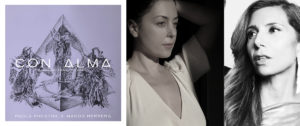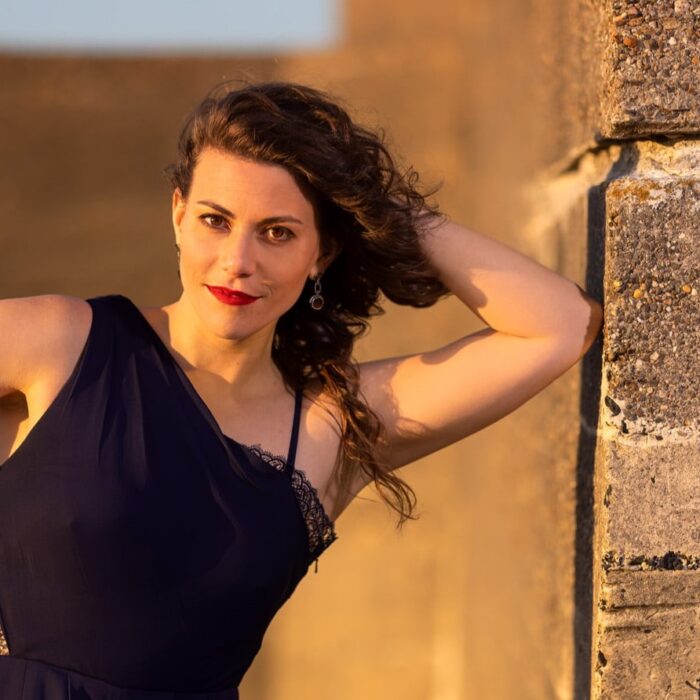
Q & A: Paola Prestini & Magos Herrera on Recording ‘Con Alma’
By Francisco SalazarOn Dec. 4, Paola Prestini and Magos Herrera released “Con Alma,” an album recorded remotely between March and October 2020 during the COVID-19 pandemic.
The new release features classic songs from the Mexican and Jazz songbook and over 30 musicians across three continents including the all-women German-based Ensemble Sjaella, Constellation Chor, the Young People’s Chorus of NYC, Mexico’s Orquesta Sinfónica de Minería, Kronos Quartet cellist Jeffrey Zeigler, Silk Road clarinetist Kinan Azmeh, guitarists Romero Lubambo and Vinicius Gomes, arranger and multi-instrumentalist Gonzalo Grau, and arranger Diego Schissi.
OperaWire had a chance to speak with Prestini and Herrera on the process of recording “Con Alma” and its significance.
OperaWire: What inspired this upcoming recording?
Paola Prestini: Our friendship inspired “Con Alma.” But also the need to feel together in the beginning of the pandemic, and to track our lives, emotions, and musical responses to one of the greatest cataclysmic events in our life into an artifact of our time. But it began as all art does, with a conversation.
Magos shared the work of the Surrealist painter Remedios Varo with me, of a nun-like figure in isolation surrounded by birds and music, and that became the inroad to a deeper discussion about creating in isolation, which led to our musical community and how we could unite them, and finally to the art work of Kevork Mourad who shares an affinity with Varo and who will be live painting on the digital experience December 13.
OW: Tell me about the repertoire and why it was important to record these Latin songs?
Magos Herrera: Paola and I weave this narrative through not only musical motifs, rhythms, and words but also understanding the total freedom we needed to create and express our own experiences. I love the balance between Paola’s choir pieces as pillars that ground the whole narrative creating depth and an ancient but still current feeling as humanity, images of Maria Magdalene, a tree and its fruits that represent the vastness and plurality of humanity and the hope of children voices aiming for a luminous future.
About my pieces. “Con Alma” means “with soul” and in that spirit I like to believe that we can use this moment as an opportunity of transformation, focusing in whatever is essential and truthful, that is what we are learning from this global pandemic, we have been forced to prioritize. “Con Alma” is also a jazz classic written by Dizzy Gillespie, I love the simplicity of it, I wanted to use my voice as the soul navigating in different stages including a beautiful “soli” written by Diego Schissi in a “chorinho rhythm” where I wanted to portrait a playful “soul’, almost like saying “all that is happening is an anima mundi’s dream.”
Throughout the album we see the element of a bird, also a metaphor of the soul, “Cucurrucucú” is a Mexican classic which talks about a dove who represents the loved one that has been gone, a recurring theme of loss during 2020. Rojo sol, written by myself, is a meditation on the uncertainty and desolation when we experienced a total lockdown, loss, and the hope to reunite with our loved ones and “Creación de las aves” written by myself in collaboration with Vinicius Gomes is a song filled with hope aiming for human transformation after this crisis
OW: Tell me about your collaboration and how much you guys had to work with each other?
PP: We began with certain parameters – we knew the album would be poly-stylistic, and we knew that we would be following a loose narrative-from the recreation of soul and humanity through a birds flight in “La Creación de Las Aves,” to the Tree of 40 Fruit (created in concept with Maria Popova) an actual tree that produces 40 different varieties of apples signifying the communal aspect of our collaboration and the shared experiences through the pandemic told through the overlaid voices of Marisa Michelson and the Constellation Chor; then the idea of the elements and our environment, seen through both Magos’ eyes in “Rojo Sol,” through children’s eyes in Thrush Song as they sing an ode to Rachel Carson’s Silent Spring, and finally Sjaella in Alma Muerta where they sing headlines culled during the pandemic and to the poetry of Alfonsina Storni (an Argentine poet of the modernist period who lived at the beginning of the 20th century) to the idea of what would have changed had Mary Magdalene been invited to the table at the last supper in Fratres featuring Sjaella and Magos.
We end the whole operatic tableau with an orchestral rendition of “Cucurrucucú Paloma.” Nature was a unifying source in the album, as well as the sounds of our surroundings during isolation. From field recordings of birds and wind, to the sounds of “La Bestia” (the train that crosses through Magos’ town in Mexico bringing migrants to the border) to cityscapes from my return to Brooklyn. This idea of frozen borders also united us-I was raised on the border in Nogales, and that cross-cultural experience informs the way I see life and make music. Magos just returned to Mexico for the first time after fifteen years in NYC.
OW: You collaborated with over 30 musicians on this album. Tell me about these collaborations and what inspired you to choose these diverse musical groups?
MH: In a way, this lineup reflects a vast picture of the emotional aspect of the narrative, from the collective to the individual experience, from a quartet to a 12-element Orquestra, from a single voice to an acapella choir. Paola’s pieces add depth and intensity with Sjaella and Constellation Chor and a luminous touch of hope through the children’s vocals from The Young People’s Chorus of New York City.
The pieces with the Orquestra—”Con Alma” and “Cucurrucucu”—I was looking for a cinematic texture where my voice could navigate effortlessly incorporating a 12 element line up from Orquesta de Minería, the other pieces are small formats, different from the traditional jazz ensembles, I wanted to find an organic woody sound incorporating cajon (Gonzalo Grau), acoustic guitar (Romero Lubambo and Vinicius Gomes), cello which at times lead the harmonic structure and in other moments creating a conversation with the lead voice (Jeffrey Zeigler) and clarinet (Kinan Azmeh).
OW: Tell me about the recording process. What was the biggest challenge of going into a studio and recording an album?
PP: The biggest challenge was that we were not in a studio! We had excellent engineers who made this possible, and we had different levels of recordings to contend with-the kids recorded with their phones, and it was the beginning of the pandemic, so we were learning so much about how to operate in a very basic way. Sjaella, the Leipzig-based sextet, recorded in a church as they had quarantined together. Maria Michelson recorded at National Sawdust, and finally Magos and the orchestra and musicians recorded with varying microphones, leaving our engineers with magic to make.
OW: What is your favorite piece on the album and why?
PP: I love “Con Alma.” It takes me back to another time, and Magos sounds so beautiful in it. She is also such an optimist and it shines through in this classic jazz piece with her twist. I love them all…but if I had to choose one of mine, I also love Fratres as it showcases Magos and Sjaella, and shows how we collaborated vocally.
MH: I love the whole album and the various emotions that it reflects. I enjoyed a lot singing in Paola’s piece Fratres, I tried to find a transformative vocal energy that could reflect such a powerful theme, what it would have happened if Maria Magdalene had been invited to the last supper. I really like the playfulness of “Con Alma” and like the organic natural sound of “Rojo Sol” which was the first piece I wrote during isolation, was my first response to it.
OW: How long was the recording process and did you feel like you needed more time?
PP: The recording process in earnest began in September across three continents, so we had two months of intense recording with the mixing happening as we were finishing. But some recordings such as the Young People’s Chorus of NYC were recorded at the beginning of the pandemic on phones, in March-April, and I love that each of these represents our capacities of recording during the pandemic.
Sjaella recorded last in Leipzig at the end of October right before the second closure, and it was so meaningful to bring music into the world before this second wave shut down most of Europe. We needed time to write, and we wanted to bring the album out in the world before the new year as we wanted to commemorate our experiences and 2020, so even though the mixing time was tight, we had a timeline to keep to-and the truth is one always feels they need more time!
OW: Tell me about the differences between recording an album from performing live?
MH: As a singer, when performing my focus is divided between the inner gesture to deliver the soul of the music, the energetic flow with the audience, and the conversation with the musicians “in the present moment.” When recording, the delivery responsibility is withdrawn and the energetic flow is condensed in entering in the soul and flow of the music-making but you have more space to explore the details, to change directions, to review your narratives.
OW: What story do you hope to tell with this new album?
PP: We hope to tell the story of two friends, with our singular proclivities and stories, combined with our view on the communal experiences of this life-defining moment in time. We want people to hear themselves in these voices, these stories, these recordings. There is a moment in the Tree of 40 Fruit where you hear fragments of stories from our social media campaign telling us of their sounds of isolation. I hope this plural experience, with all its complex differentiation, brings us together to understand the importance of human and natural connectedness.
MH: That we can use this moment as an opportunity for transformation and redirect our efforts as humanity prioritizing all that is essential and truthful.


